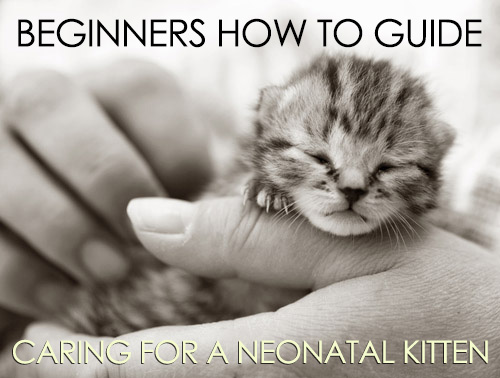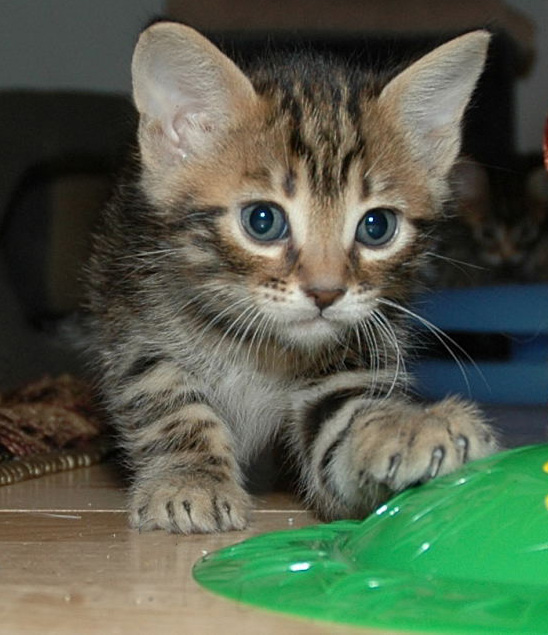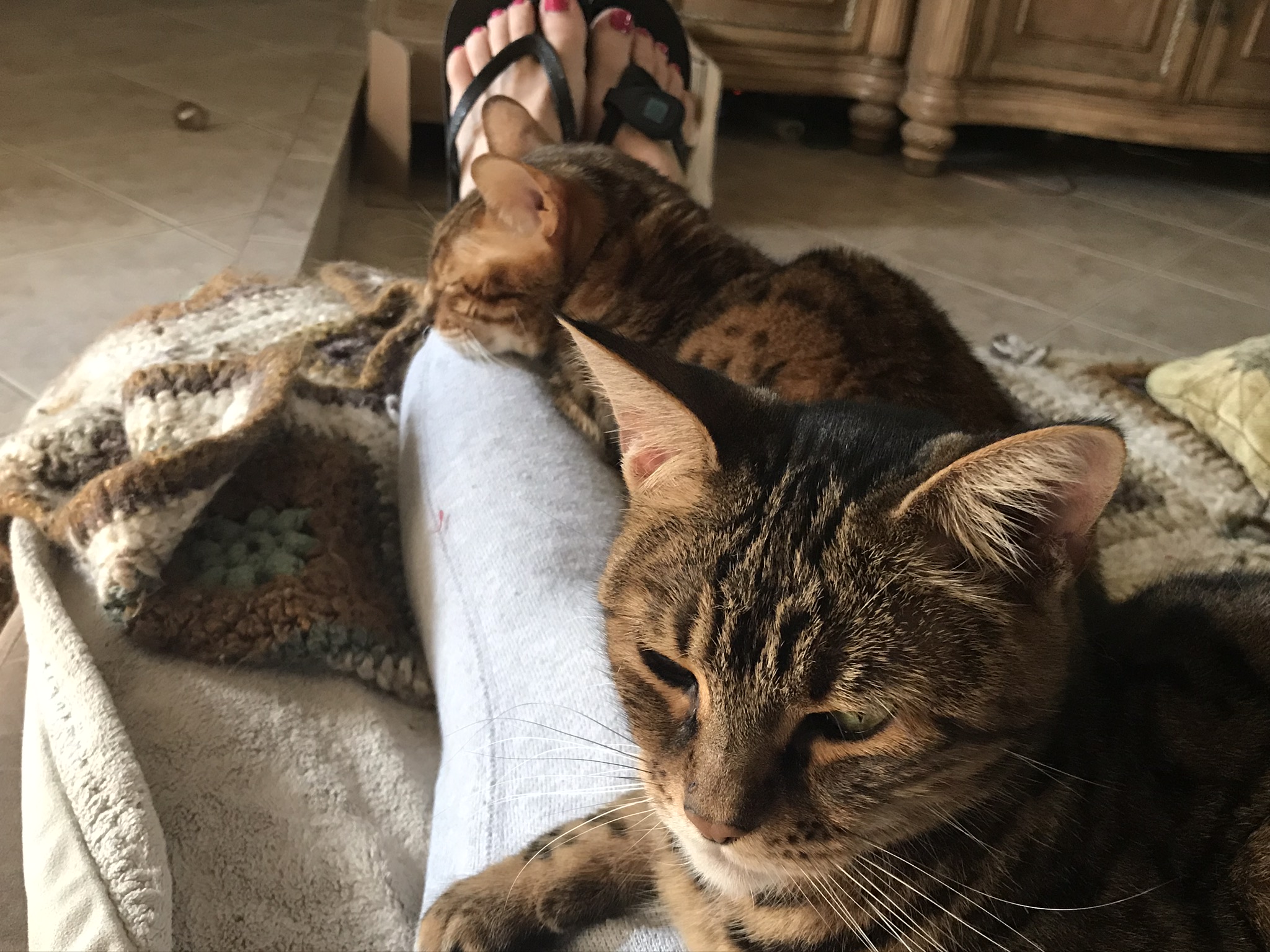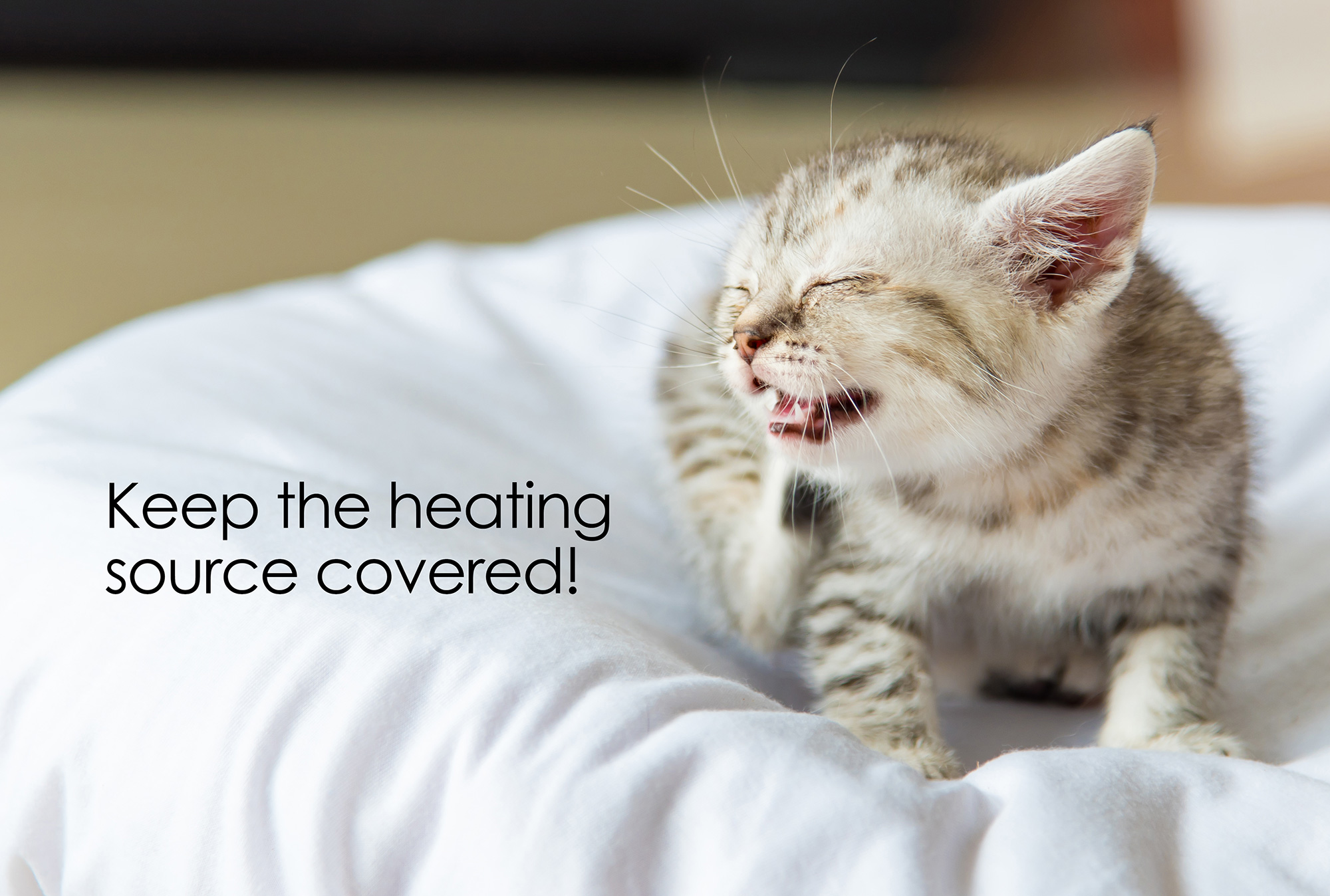Beginner’s Guide to Caring for An Abandoned Neonatal Kitten
It was around 8:00 p.m., and Dan and I were finally settled on the couch for the evening. I think I had at least two cats sleeping on me and Dan one or two. Dan’s phone rang – it was a co-worker. He had found an abandoned neonatal kitten (neonatal is a kitten defined as newborn to four weeks old) at the facility where they work, outside in the rain, and he needed help. The mother cat was nowhere to be found, nor were there littermates. It was clear if he didn’t intervene, the kitten would not survive.
My brain went into a convoluted stream of consciousness while Dan talked to him: “It’s dark out…I can’t drive…no stores are open that sell kitten formula…I’ll need to Google to figure out what to feed an abandoned kitten…we already have seven cats…they will spray in the house to mark territory if they sense a newcomer…where will we put it…I guess I could set something up in the spare bedroom…I have two Zoom meetings tomorrow morning for work…how do I get to Pet Supermarket to pick up kitten formula before the meetings…this will be a nightmare because I’m already thinking of names for the kitten…I know we’ll end up keeping it…”
Naturally, these words came out of my mouth without hesitating: “Tell him to bring the kitten to our house, and we’ll figure it out.” After Dan ended the phone call, he commented that it was odd we were in this situation! Odd? Honestly, I find it odder that we don’t find our phone ringing off the hook with people asking us for help with an abandoned cat they’ve found or waking up every morning to a basket full of kittens at our doorstep. We are known cat lovers, both in our public and private lives, so the fact we are relatively undistributed is a miracle as far as I’m concerned.
All kidding aside, this was a very serious situation. Dan’s friend said he had a few more calls to make, but the kitten would be coming to our house if they didn’t pan out. Luckily, he found someone who worked at Pet Supermarket and had experience with neonatal kittens. But that brings me to an important subject. What do you do if you find a neonatal kitten and you’re not prepared to care for it? Or what if you don’t have a background in kitten care? The pet stores are closed, online deliveries are unavailable, and you don’t have kitten-saving supplies ready. Time is of the essence, and if you start off on the wrong foot, it could have dire consequences for the kitten, despite your kind heart and best intentions. This brought me to create a step-by-step guide on what to do and how to care for an abandoned neonatal kitten.

1. Assess the situation. Hannah Shaw, founder of the rescue and advocacy project Kitten Lady, says don’t assume a kitten is orphaned just because you don’t see the mom. Moms sometimes leave to find food or to move the litter (one kitten at a time) to another location or for other reasons. Give the kitten some distance – at least 35 feet – and see if mom comes back (she may not approach if you stand too close). If she returns, that’s ideal. Much as you may want to intervene, she’s best suited to care for her baby. If you want to help, you can return later with a makeshift shelter, such as a Styrofoam cooler with a cutout doorway, high-calorie cat food, and fresh water for mom. Keep the food at a distance from the shelter and pick up all food at night so as not to attract predators.
If she does not return within a few hours, or if you can’t wait for her to return, carefully evaluate the situation. Is the weather inclement? Are there dogs, wild animals, or predators that might harm the kitten if left alone? Is the kitten located in an area with heavy foot or car traffic? Does the kitten appear to be lethargic, injured, or sickly? If the answer is yes to one or more of those questions, it’s time to step in and help.
2. Stay calm and act quickly. Gather the kitten and plan for the next 24 hours of care. You can change your plans later, but the kitten needs immediate attention. If you observe serious health concerns such as gasping for air or bleeding, take the kitten to a veterinarian or an emergency after-hours pet clinic. Above all, according to Alley Cat Allies, the kitten should not be brought to a shelter, which can lead to a death sentence. You can call for guidance, but most shelters do not have neonatal programs to provide the extensive, around-the-clock care needed for an unweaned kitten to survive. The shelter environment can also be dangerous for kittens because their immune systems haven’t fully developed, and they can easily catch diseases. First, contact veterinarians, local non-kill rescues, and animal protection groups to see if they have a nursing mother cat to “adopt” the kitten or experienced volunteers available to offer advice or even help bottle feed the kitten. If they can’t help, or if you can’t commit to the care yourself, see if a friend or family member could.
3. Stabilize the kitten. The next step is to get the kitten warm, hydrated, and fed quickly. Shaw says, “Because kittens cannot control their body temperature, ensure the kitten is not hypothermic and help them regulate their body temperature BEFORE feeding them – especially if they have been exposed to cold temperatures.” A heating pad on low, a warm water bottle, or even a sock filled with rice* can all provide a steady but mild heat source to a cold kitten. Whatever method you use, all heat sources should be covered so the heat doesn’t come into direct contact with the skin. If you have none of the above on hand, use your own body heat to warm the kitten, rubbing gently to aid circulation.
*Click here for how-to instructions from Healthline.com to make a homemade rice heating pad.
4. Feeding Time. Generally, if you find an orphaned kitten, they have already gone too long without food and need nourishment immediately. According to the VCA Animal Hospital, a neonatal kitten has a delicate immune system, supported in the first few days of a queen’s milk, known as colostrum. It’s very high in protein and sets the stage for a kitten’s protection from disease. Grabbing milk from your refrigerator is NOT an acceptable substitute, as cow’s milk can cause diarrhea, a possibly life-threatening condition for neonatal kittens.
They recommended kitten milk replacers, such as PetAg KMR, which can be purchased online at sites like Amazon or Chewy, most pet supply stores, and even Walmart and Target. But what if it’s after hours, and you can’t get to a store or get an online delivery for the proper formula? At the very least, you should be able to find supplies in your kitchen, at the grocery store, or even at a convenience store to make a temporary formula until you can get what you need. Alley Cat Allies recommends this simple homemade recipe:
1 8 oz. can of Evaporated Milk
1 egg yolk, beaten
2 tablespoons Karo syrup
Mix well. Keep in an airtight container and refrigerate unused portions (use within one week or less).
5. Find a safe spot and build a “nest.” After the kitten is stabilized and fed, find a cozy, safe place away from any potential hazards and build a nest with a warm heating source that is completely covered with a blanket or towel, with the option the kitten can move away from the heat if they want. A box or a cat carrier are good options, and it will also be necessary to change the bedding daily or when they have accidents. If you have other pets in the house, to prevent the possibility of spreading viruses between the kitten and them, keep a “kitten gown” (a robe, sweatshirt, etc.) in the kittens’ room to wear during feeding and handling and always remember to wash your hands well before and after handling the kitten.
As the kitten progressively ages, it should remain in a carrier or box in a safe room where the door can be shut. The kitten will also need to be able to leave the confines of their nest to explore, play, use the litterbox, and more. Check the room for any potential dangers. Lock away cleaning chemicals, hide exposed electrical cords, tie up pull cords on blinds, and remove dangerous houseplants or flowers. They will need a litterbox, food and water dishes, soft blankets or a cat bed, a scratcher, and various kitten-safe toys. Toys with small bells or pieces that can be ingested are dangerous, and any toy with a string should always be used with supervision and put away when done playing with, as they can easily ingest the string.
HOW TO DETERMINE HOW OLD A KITTEN IS FROM BIRTH TO EIGHT WEEKS FOR FEEDING NEEDS
 Newborn – under 1 week. The umbilical cord is attached, eyes closed, ears folded down, can’t regulate body temperature, and can’t walk. Will need to be stimulated to go to the bathroom (see instructions in the ELIMINATION section of the guide).
Newborn – under 1 week. The umbilical cord is attached, eyes closed, ears folded down, can’t regulate body temperature, and can’t walk. Will need to be stimulated to go to the bathroom (see instructions in the ELIMINATION section of the guide).
 1 week. Their eyes are closed (they open at about 8-12 days), their ears are folded, and they have no umbilical cord. They can start to crawl, snuggle, and knead. They will need to be stimulated to go to the bathroom.
1 week. Their eyes are closed (they open at about 8-12 days), their ears are folded, and they have no umbilical cord. They can start to crawl, snuggle, and knead. They will need to be stimulated to go to the bathroom.
 2 weeks. Their eyes are completely open and blue. They respond to noises and movement and take their first wobbly steps. They will need to be stimulated to go to the bathroom.
2 weeks. Their eyes are completely open and blue. They respond to noises and movement and take their first wobbly steps. They will need to be stimulated to go to the bathroom.
 3 weeks. Incisors emerge, ears point upward, and they begin to explore their surroundings. They transition from being stimulated to go to the bathroom to learning how to use the litterbox.
3 weeks. Incisors emerge, ears point upward, and they begin to explore their surroundings. They transition from being stimulated to go to the bathroom to learning how to use the litterbox.
 4 weeks. The canines are emerging, their vision is improving, and they are confidently walking, playing, and pouncing. They will generally use the litterbox.
4 weeks. The canines are emerging, their vision is improving, and they are confidently walking, playing, and pouncing. They will generally use the litterbox.
 5 weeks. Premolars are emerging; they are starting to wean slowly from nursing and can lap up kitten formula, eat soft food, and use the litter box.
5 weeks. Premolars are emerging; they are starting to wean slowly from nursing and can lap up kitten formula, eat soft food, and use the litter box.
 6 weeks. Deciduous teeth fully emerge, perfecting the kitten’s ability to eat wet food. This is the standard age for a kitten to receive its first FVRCP vaccine.
6 weeks. Deciduous teeth fully emerge, perfecting the kitten’s ability to eat wet food. This is the standard age for a kitten to receive its first FVRCP vaccine.
 7 weeks. They will have all their baby teeth; most are fully weaned onto wet food. At this age, the adult eye color will emerge and change from baby blue to the eye color they will keep permanently.
7 weeks. They will have all their baby teeth; most are fully weaned onto wet food. At this age, the adult eye color will emerge and change from baby blue to the eye color they will keep permanently.
 8 weeks. They eat independently, are socialized, and, if at 2 pounds or over, can be spayed or neutered and adopted into a loving forever home.
8 weeks. They eat independently, are socialized, and, if at 2 pounds or over, can be spayed or neutered and adopted into a loving forever home.
FORMULA/BOTTLE FEEDING INSTRUCTIONS
(See kitten weight/feeding chart below)
Once you determine the kitten’s age and it’s warm and stabilized, you must begin a feeding schedule as soon as possible. A kitten bottle should be used, but if you don’t have one on hand until you can get one, you can use something such as an eyedropper, a syringe, a slim straw, or a terry cloth or sponge dipped in the formula. The formula that has been in the refrigerator must be warmed before feeding. Do not heat the bottle in the microwave. Instead, heat a mug of water and place the bottle in the mug for a few minutes. Before feeding, test the temperature of the formula by placing a few drops on your inner wrist to be sure it is not too hot. Always wash your hands well with soap and water before and after feeding the kitten.
On the advice of Best Friends Animal Society, when bottle nipples are brand new, you may need to cut an X in the tip of the nipple using small, sharp scissors. Or you can burn a hole in the nipple using a large needle. Heat the needle with a match, then poke it through the nipple tip. Once the hole is made, test it by placing the nipple on a formula bottle and turning it upside down. The formula should drip slowly out of the hole. If the hole is too big, the kitten will ingest too much formula too fast; if it is too small, it will have to work harder and won’t eat as much as it should.
According to Kitten Lady Hannah Shaw, you first want to lay the kitten in a natural, belly-down position, NEVER on its back. The kitten should be its stomach like it would lay next to its mother when nursing. Hold its head stable with your non-dominant hand. Gently slide the nipple into the kitten’s mouth, holding the bottle at a 45-degree angle to keep air from getting into its stomach and start the flow of formula. The kitten should roll its tongue into a U-shape and begin to swallow. If the bottle appears to collapse, gently remove the nipple from its mouth and let more air return to the bottle.
If the kitten latches, that’s great, but it could take time to get the hang of it, so be patient and don’t give up. If it’s having difficulty, Shaw says to be sure you hold its head and body stable to guide it, as the kitten might not understand what you’re trying to do. Also, check the bottle and nipple to make sure there are no issues, such as a nipple that is cut too big or too small or clumps in the formula that may be causing a blockage. It might help to swaddle the kitten (still belly down) in a warm towel or lay it on your lap. Rubbing the kitten’s face gently with a cloth or soft-bristled toothbrush can simulate a mother’s tongue and help it feel prepared to eat.
After feeding the formula, the kitten should be burped. Put it on your shoulder or its stomach and pat it gently until you feel a burp. Kitten formula is sticky, too, and any left behind can cause the kitten to get a crusty face or moist dermatitis that causes the fur to fall out, so keep the face clean, washing it with a warm, damp washcloth.
ELIMINATION & LITTERBOX TRAINING
Because kittens under 4 weeks old can’t pee or poop on their own (mom licks them to stimulate elimination and urination), you’ll need to help them after each feeding. Use a warm, wet cloth and rub their genital area in a circular motion. Mom also licks her kittens to keep them clean, so if they need to be cleaned up, wash up those areas, too. Avoid the eyes, and dry the kitten fully to avoid chills.
Once the kitten has reached 3 weeks, you can introduce it to the litterbox. Be patient and continue stimulating until you’re confident the kitten uses the litterbox regularly. Choose a kitten-safe litter without fragrances, harsh chemicals, or clumping properties. Clumping litter might be the standard for adult cats, but for curious kittens who like to ingest everything, it’s a risk and should not be provided until the kitten is at least 2-3 months old. Instead, opt for a natural, pellet-based litter.
Provide an open-top, shallow litterbox that is easy for the kitten to locate and walk in and out of until it’s big enough for an adult litterbox. Kittens tend to be drawn to corners or other areas away from their main home base, so start by placing the litterbox in a corner free from clutter (messy areas such as piles of laundry are a magnet to a kitten and can encourage bad litter habits). A pee pad under the box will make clean-up easier, too, as kittens can be messy learners.
Kittens do well with positive reinforcement, never punishment. Provide praise when the litterbox is used correctly, and if the kitten goes in an area outside of the box, immediately clean and disinfect the area to avoid scent soaking or scent associations. Be sure to dry the area you have cleaned fully so no dangerous chemical residue can get on any of the kitten’s paws. A 1:1 water mix and white vinegar can be a safe cleaning alternative to chemical sprays.
WEANING INSTRUCTIONS
Weaning a kitten is a process and should be done gradually, beginning at approximately 5 weeks of age when the premolars emerge. Weaning is done with bottle feeding and should happen on the kitten’s timeline, not yours. Some kittens need more time, some less, depending on health, weight, and more. If you see any changes in the kitten’s health or energy during the process, step back to the bottle feeding.
1. Purchase wet kitten food formulated with the higher calories, fat, and protein it needs to grow big and strong (several varieties are available in stores and online, such as Wellness, Fancy Feast, Purina, Orijen, Weruva, Royal Canin, and Hills, to name a few). The moisture will also help keep the kitten hydrated.
2. Offer the kitten some small bites of wet food on a finger, a spoon, or a tongue depressor and see if it’s interested. If so, put some food in a shallow dish and see if it can manage. Remember, this is a new skill, so it may take a few days to figure it out. That’s why it’s important to supplement feedings with a bottle to ensure the kitten is getting all the calories and nutrition it needs while weaning.
You can also use a slurry (a mix of formula and wet food) to help transition the kitten. Start with a teaspoon of wet food mixed with the formula to allow the kitten to acclimate to the new proteins and flavors. As it becomes more comfortable eating the semi-solid mixture, you can increase the ratio so there is more wet food at each feeding.
3. Once the kitten is confidently eating independently, you can stop with the supplemental feeding and switch to a full-time diet of high-quality solid foods formulated for kittens. Monitor it for weight, behavior, or condition changes.
4. At this time, water should also be introduced to the kitten in a small, shallow dish. Never provide a large dish that can cause a safety hazard to a tiny kitten; keep your water dish to about 2 inches high. It’s normal for kittens to struggle with water initially, but within 1-3 days of introduction, they should be drinking confidently.
 Leftover canned food can be kept in the refrigerator in an airtight container for up to five days. Kittens typically prefer their food to be warm, so if using cold food from the refrigerator, either take it out to warm it up or put the food into something water-resistant and airtight and submerge it in hot water for a few minutes to warm it.
Leftover canned food can be kept in the refrigerator in an airtight container for up to five days. Kittens typically prefer their food to be warm, so if using cold food from the refrigerator, either take it out to warm it up or put the food into something water-resistant and airtight and submerge it in hot water for a few minutes to warm it.
Do not use a microwave as it can unevenly distribute the heat. Some studies also suggest microwaving can cause the fat molecules in the food to change radically, making them less digestible and, ultimately, harmful to the kitten’s long-range health. Furthermore, microwaving in a plastic container could also be dangerous to a kitten. A researcher at John Hopkins University said, “Phthalates are environmental contaminants that can exhibit hormone-like behavior by acting as endocrine disruptors in humans and animals. If you heat up plastics, you could increase the leaching of phthalates from the containers into water and food, increasing the likelihood of pulling chemicals out whenever you heat something.”
This article was primarily focused on caring for an abandoned neonatal kitten at its various life stages. There is significantly more to it, such as the long-term plan. Will you permanently adopt the kitten, or will it be placed in a foster home, or will you eventually look to find the kitten a forever home after it is suitably socialized and weaned at around 8 weeks of age? Whatever the decision, when you took the kitten in your care, a commitment was made to save its life.
Numerous other scenarios with lengthy, detailed information can be found, such as caring for more than one abandoned kitten, caring for kittens if found outdoors with their mother, preparing kittens for socialization and adoption, TNR (trap, neuter, return) in which the kitten is brought back to live within its outdoor colony, vaccinating a kitten, how to manage a kitten with fleas or an illness, and much more. There are many resources and sites available to answer those questions. My favorites are Hannah Shaw’s Kitten Lady website, which has a wealth of in-depth articles and videos on every kitten subject imaginable, and Alley Cat Allies, which provides invaluable advice on proper cat care for stray and community cats, also with in-depth information on every scenario imaginable, and the National Kitten Coalition which provides numerous articles and resources, and even an eLearning Center with a variety of educational, hands-on webinars on kitten care.































Thank you for this informative and educational post, which I’m sharing on social.
However, there are two major problems for so many well-intentioned and caring people. The first is time constraints. The second is financial constraints. If someone would address those realistically, it would, I’m sure, be very helpful.
Yes, excellent points, jmuhjacat. I’m sure so many people look at a kitten as a fun, cute ball of fluff, wanting to assist. The overall scope on all ends is extensive – time and cost, especially. I’m sure it’s an unfortunate reason as to why some kittens end up in a shelter. It will be a good topic for me to delve into one of these days so that I can hopefully shed light, with realistic and practical solutions.
Excellent post. That was kind of you to help the kitten.
Thank you, Ellen. We are just grateful he was able to find someone with experience to take it. We’ve gotten an update that its eyes are now open!
Mee-yow Miss Debbie an Mistur Dan you sure are sweet an kind Peepell.
There iss a wee kitt in our Recue group’ss care named Mia an shee iss a New-natal kitt fore sure. Shee iss a golden Tabby alot like THE one inn fotoss an shee iss cute as a button. BellaSita meeted her a few weeks ago. Cuud not touch her butt meowed to her an Mia meowed back. Mia iss now 6 weekss old an gettin stronger dailee!
Thanx fore yore post! BellaSita leerned alot 😉
***nose rubss*** BellaDharma an {{hugss}} BellaSita Mum
Aww! So glad Mia is getting the care she needs to grow up to be a big, strong, healthy kitty! We are glad you learned alot, too!